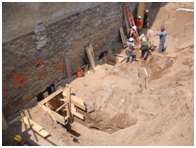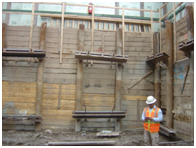Once the subsurface investigation is complete, the next step in the process is the design of the foundation along with the design for support of excavation along open lot lines and underpinning of the neighboring buildings along common lot lines.
Conventional shallow concrete foundations (spread footings and mat slabs) are always the first choice for any new project due to their simplicity of construction and cost efficiency. Rigorous interaction analyses are performed to evaluate the performance of shallow foundations. When the predicted interaction produce unacceptable structural deflections, appropriate deep pile or caisson foundations are evaluated for the project.
After selection of an appropriate foundation system, the general requirements for support of excavation and underpinning of neighboring buildings are determined. The subsurface conditions are again evaluated along with the foundation conditions supporting the neighboring structures discovered in the investigation. Here again, rigorous analysis of the soil behavior is performed and support of excavation and underpinning designs are developed to limit potential damage to existing structures and nearby underground utilities.
 Bedrock |
 |
 |
 |
 |
 Structure |

